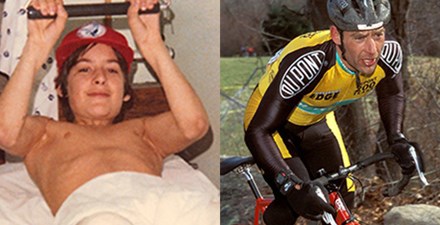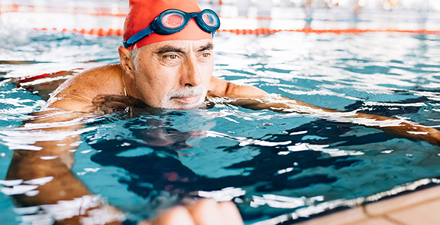Physical Therapy Guide to Osteoarthritis of the Spine
Osteoarthritis of the spine is a condition that usually occurs with aging and is typically diagnosed after age 50. Its causes include injury to the spine, wear and tear on the discs of the spine (often associated with obesity), or an inherited tendency to develop OA. Sometimes the cause is unknown. OA of the spine may cause pain and stiffness, and make it difficult to bend over, perform weight-bearing activities, such as walking, and accomplish daily tasks such as dressing and bathing. Your physical therapist will help you manage your condition, lessen your discomfort, and get moving again.
Physical therapists are movement experts. They improve quality of life through hands-on care, patient education, and prescribed movement. You can contact a physical therapist directly for an evaluation. To find a physical therapist in your area, visit Find a PT.
What Is Osteoarthritis of the Spine?
As we age, the discs in our spine (gel-filled cushions between the bones of the spine) can wear, narrow, or begin to bulge. These changes can put strain on the cartilage, ligaments, and joints at the involved level of the spine and may result in pain. The narrowing of the disc also results in narrowing of the space between the spinal joints, called the "facet" joints. Weight-bearing forces on the joints increase because of these disc changes. As a result, the cartilage covering the joint surface can begin to fray and wear away over time. This wearing down results in osteoarthritis (OA).
As OA of the spine progresses, your body will try to repair it by growing new bone. This bony growth is called a "bone spur." Spur development can result in a condition known as spinal stenosis. Most often this disorder affects men and women over 50 years of age. If the spurs enlarge, they can create a narrowing of the spaces in the spine. The narrowing can involve small or large areas and can result in pressure on nerves near the involved joints, resulting in symptoms that may include pain, tingling, numbness, or burning.
How Does It Feel?
Symptoms of OA of the spine vary from person to person and can range from mild to disabling. You may not have symptoms even though the condition is present. Its onset and progression can be quite slow.
With early or mild disease, symptoms may be intermittent. You might feel stiffness or aching after sitting a long time, on waking in the morning, or after vigorous activity. You or your family may notice changes in your posture. Some people will bend forward or shift to the side. With more advanced OA of the spine, symptoms will become more constant and tend to interfere more with your daily activities, especially with walking and standing.
Common symptoms of OA of the spine include:
- Pain in the back or neck.
- Pain that is worse after prolonged inactivity, on getting up in the morning, or after physical activity.
- Pain that worsens with standing and walking, and gets better with sitting or lying down.
- Stiffness after prolonged inactivity, on getting up in the morning, or with movement of the involved area of the spine.
- With a more advanced condition, symptoms that do not improve with rest and that interfere with sleep.
- Pain, burning, or tingling sensations that spread to the shoulder or arm, or to the buttocks or leg.
- Difficulty performing normal daily activities, such as dressing and bathing, as well as walking and standing, as the condition progresses.
How Is It Diagnosed?
Your physical therapist will perform a thorough evaluation and ask you questions in order to form a clear picture of your individual situation. These questions may include:
- Your past and current health and use of medication.
- How you are functioning in your daily life. (You may be asked to fill out a questionnaire.)
- How your symptoms came about.
- How long you have had symptoms.
- Where the symptoms are located.
- How and when pain occurs.
Your physical therapist will then conduct a physical examination and may:
- Evaluate your posture and measure the range of motion of your spine.
- Assess the movement of the spine and extremities (arms or legs) in the involved area.
- Check your nerve function with reflex, sensation, and strength testing.
- Observe how you move during commonly performed activities.
- Check your balance to determine your risk of falling.
The information learned in your evaluation will help your physical therapist prescribe a program to ease your discomfort, boost your quality of life, and get you moving your best.
If your physical therapist suspects that your pain might be caused by an underlying condition, they may request imaging testing such as X-rays, CT scans, and MRI from your doctor. Your therapist may also refer you to your doctor for further evaluation. Your physical therapist will work with your doctor to provide the best diagnosis and treatment.
How Can a Physical Therapist Help?
Your physical therapist will help you set goals to reduce your symptoms and slow the progression of the disease. You'll learn how to safely exercise and continue to participate in your normal daily activities.
Your physical therapist can help with a variety of treatment options, including:
Exercise. Exercise is the most important treatment to lessen your pain and improve your mobility. Your physical therapist will prescribe specific low-impact activities that will strengthen your spine, abdomen, and hip muscles—to improve your ability to stand, walk, and balance, and lower your risk of falling.
Caution: Please consult your physical therapist or doctor before starting any exercise program.
Stretching. Your physical therapist will prescribe specific stretching exercises for your spine, arms, or legs based on the results of your initial evaluation. Obese individuals are in special need of stretching and exercises. Combined with strengthening, stretching may help slow the progression of the disease.
Symptom management. Symptom management means learning to feel better and remain active. Sometimes people are fearful that increased activity will worsen their symptoms or increase their pain. Your physical therapist will help you learn how to be more active without worsening your symptoms. The therapist will help you find your appropriate activity levels, and develop a unique program to keep you moving.
Daily activity training. Your physical therapist can teach you how to get in and out of bed, in and out of the bathtub, or out of a chair, and how to bend and walk with more ease.
Use of modalities. Treatment modalities, such as heat or ice, may be used to help manage your symptoms.
Manual therapy. Your physical therapist may use gentle hands-on techniques (manual therapy) to help improve your spinal flexibility and ease stiffness.
Balance and walking training. Exercises and instruction may be used to safely improve your balance and reduce your risk of falls.
Specialized braces or taping. Your physical therapist may use taping or specialized braces to help support your joints. Back bracing may be used in more advanced conditions.
Weight control. If you are obese, you are likely to have more spinal impairment in your upper back. Your physical therapist can help you improve your activity levels, and refer you to nutritional experts.
All cases of OA of the spine are different. Your physical therapist will choose the best treatment options for you based on their evaluation of your specific problem.
Following Surgery
The predominant treatment for OA of the spine is nonsurgical. However, symptoms that interfere with bowel or bladder function and cause problems with the nervous system may require surgery.
Immediately after surgery, a physical therapist will visit you in the hospital to help you get out of bed and walk, and possibly use a cane or walker for safety. When adequate healing has occurred, you may be sent for outpatient physical therapy to continue to improve your walking, and to provide you with an exercise program to safely improve your specific condition.
Can This Injury or Condition Be Prevented?
OA occurs as you age, but is not a direct result of getting older. There are many factors that may put you at risk of developing OA, including your family history. Other factors include exposure to risks at work such as assuming prolonged or awkward positions and smoking. Regular conditioning and strengthening exercises will improve the ability of your muscles to work and may help prevent OA of the spine.
What Kind of Physical Therapist Do I Need?
All physical therapists are prepared through education and clinical experience to treat OA of the spine. However, you may want to consider:
- A physical therapist who has treated people with OA of the spine. Some physical therapists have a practice with an orthopedic or geriatric focus.
- A physical therapist who is a board-certified clinical specialist or who completed a residency or fellowship in orthopedic or geriatric physical therapy. This physical therapist has advanced knowledge, experience, and skills that may apply to your condition.
You can find physical therapists who have these and other credentials by using Find a PT, the online tool built by the American Physical Therapy Association to help you search for physical therapists with specific clinical expertise in your geographic area.
General tips when you're looking for a physical therapist (or any other health care provider):
- Get recommendations from family and friends or from other health care providers.
- When you contact a physical therapy clinic for an appointment, ask about the physical therapists' experience in helping people with OA of the spine.
- Be prepared to describe your symptoms in as much detail as possible, and report activities that make your symptoms worse.
Other Arthritis Resources
The American Physical Therapy Association launched a national campaign to raise awareness about the risks of opioids and the safe alternative of physical therapy for long-term pain management. Learn more at our Safe Pain Management page.
The American Physical Therapy Association believes that consumers should have access to information that can help them make health care decisions and also prepare them for their visit with their health care provider.
The following articles provide some of the best scientific evidence related to physical therapy treatment of hip osteoarthritis and hip replacement. The articles report recent research and give an overview of the standards of practice both in the United States and internationally. The article titles are linked either to a PubMed* abstract of the article or to free full text, so that you can read it or print out a copy to bring with you to your health care provider.
Goode AP, Carey TS, Jordan JM. Low back pain and lumbar spine osteoarthritis: how are they related? Curr Rheumatol Rep. 2013;15(2):305. Free Article.
Vismara L, Menegoni F, Zaina F, et al. Effect of obesity and low back pain on spinal mobility: a cross sectional study in women. J Neuroeng Rehabil. 2010;7:3. Free Article.
Kalichman L, Li L, Kim DH, et al. Facet joint osteoarthritis and low back pain in the community-based population. Spine (Phila, Pa 1976). 2008;33:2560-2565. Free Article.
US Department of Health and Human Services. The Surgeon General's Call to Action to Prevent and Decrease Overweight and Obesity. Rockville, MD. US Dept of Health and Human Services, Office of the Surgeon General; 2001.
National Institutes of Health. National Institute of Arthritis and Musculoskeletal and Skin Diseases. Spinal stenosis. Accessed August 30, 2018.
Arthritis Foundation. When Back Pain May Mean Arthritis. Accessed June 16, 2020.
Arthritis Foundation. Arthritis Today. Accessed June 16, 2020.
US Department of Health and Human Services, Office of Disease Prevention and Health Promotion. Physical activity guidelines for Americans. Accessed August 30, 2018.
*PubMed is a free online resource developed by the National Center for Biotechnology Information (NCBI). PubMed contains millions of citations to biomedical literature, including citations in the National Library of Medicine’s MEDLINE database.
Expert Review:
Sep 3, 2018
Revised:
Sep 3, 2018
Content Type: Guide
Osteoarthritis of the Spine
PT, board-certified clinical specialist in orthopaedic physical therapy
Elizabeth Poppert
PT, DPT, board-certified clinical specialist in orthopaedic physical therapy
You Might Also Like...
Health Tips
Arthritis: Find a Community-based Physical Activity ProgramJan 16, 2024
Regular physical activity can benefit your physical, mental, and social health, and prevent or improve many chronic conditions. These community-based physical
Patient Stories
'My Life Has Been Given Back To Me By A Physical Therapist'Jul 28, 2021
Today he is a professional cyclist and a physical therapist. But as a teenager Tim Haitz moved so awkwardly that other kids called him "swivel."
Health Tips
Exercise for Arthritis: What You Should KnowMay 26, 2016
Do you have stiff, achy, painful joints? You're not alone.


